

A K-5 Roadmap for Combining Content and Computational Thinking in Any Classroom. Carl Hooker with Heidi Williams Computational thinking is an essential component in finding solutions to everyday problems.

It teaches reasoning, creativity and expression, and is an innovative way to demonstrate content knowledge. (2) CAL Video. Coding as Another Language – DevTech Research Group. Developing literacy involves acquiring new skills and ways of thinking about ourselves and the world.
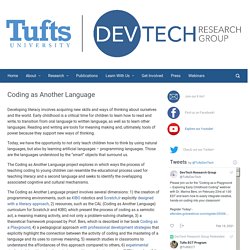
Early childhood is a critical time for children to learn how to read and write, to transition from oral language to written language, as well as to learn other languages. Reading and writing are tools for meaning making and, ultimately, tools of power because they support new ways of thinking. Today, we have the opportunity to not only teach children how to think by using natural languages, but also by learning artificial languages – programming languages.
Those are the languages understood by the “smart” objects that surround us. The Coding as Another Language project explores in which ways the process of teaching coding to young children can resemble the educational process used for teaching literacy and a second language and seeks to identify the overlapping associated cognitive and cultural mechanisms. Coding as a Playground. Coding as a Playground Book Guide This book guide below aligns with chapters from the book, Coding as a Playground (2nd ed.) by Marina Umaschi Bers.

Each section provides reading guidelines, activity suggestions for hands-on play, prompts to reflect on new learning, and opportunities to take the concepts discussed in the chapter further with additional resources. Please note that you will need access to a copy of the book to follow along. Introduction1234567891011121314Conclusion. View Recording. Pensamiento Computacional. Pensamiento Computacional. (50) Programando en papel cuadriculado. Minescratch by campusvirtualintec. Bebras 1. ↓↓ DESAFÍO CAMINO A ROSARIO ↓↓ Club de programación de la 11.
Capítulo 2: Abstracción. Computational thinking test for beginners. View Recording. DevTech Research Group. The Developmental Technologies Research Group, directed by Prof.
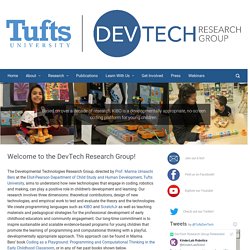
Marina Umaschi Bers at the Eliot-Pearson Department of Child Study and Human Development, Tufts University, aims to understand how new technologies that engage in coding, robotics and making, can play a positive role in children’s development and learning. Our research involves three dimensions: theoretical contributions, design of new technologies, and empirical work to test and evaluate the theory and the technologies. Coding Robots for STEAM Learning. Digital Technologies Hub. Progresiones de los aprendizajes para el pensamiento computacional. CS145_ScratchJr curriculum. Computational Thinking and Programming. ¿Qué es Código 21? Código 21 es el espacio del Departamento de Educación de Gobierno de Navarra dedicado al aprendizaje de programación, robótica educativa y otras tecnologías emergentes que permiten disfrutar y aprender con herramientas digitales de nuestro tiempo.
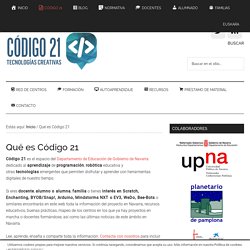
Si eres docente, alumno o alumna, familia o tienes interés en Scratch, Enchanting, BYOB/Snap! (More than) 4 examples of computational thinking in journalism. Today I will be introducing my MA Data Journalism students to computational thinking techniques (you can read my post about why that’s important here).

As part of my preparations I’ve been collecting some of my favourite examples of computational thinking being used to spot and execute data journalism stories – and I’m sharing them here… Story 1: Which singer has the biggest vocal range? This story, published in the UK tabloid newspaper The Mirror, is a great example of understanding how a computer might ‘see’ information and be able to help you extract a story from it. The data behind the story is a collection of over 300,000 pieces of sheet music. On paper that music would be a collection of ink on paper. 472.11CTTeacherResources_2ed. Creative Computing. 7 units44 activitiesremixing encouraged download the guide> help learnerscreate new worldswith computing download the guide.

Computational Thinking. In our conversations with Scratchers, we heard young designers describe evolving understandings of themselves, their relationships to others, and the technological world around them.
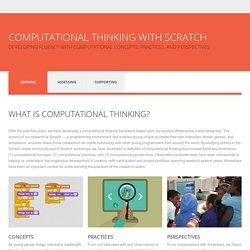
This was a surprising and fascinating dimension of participation with Scratch — a dimension not captured by our framing of concepts and practices. As the final step in articulating our computational thinking framework, we added the dimension of perspectives to describe the shifts in perspective that we observed in young people working with Scratch, which included three elements: expressing: realizing that computation is a medium of creation, "I can create. " connecting: recognizing the power of creating with and for others, "I can do different things when I have access to others. " questioning: feeling empowered to ask questions about the world, "I can (use computation to) ask questions to make sense of (computational things in) the world. " Computational Thinking for Educators - - Unit 1 - Introducing Computational Thinking.
Computational Thinking (CT) is a problem solving process that includes a number of characteristics and dispositions.

CT is essential to the development of computer applications, but it can also be used to support problem solving across all disciplines, including the humanities, math, and science. Students who learn CT across the curriculum can begin to see a relationship between academic subjects, as well as between life inside and outside of the classroom. This course provides an opportunity to experience some of the elements of CT, including: Decomposition: Breaking down data, processes, or problems into smaller, manageable parts Pattern Recognition: Observing patterns, trends, and regularities in data Abstraction: Identifying the general principles that generate these patterns Algorithm Design: Developing the step by step instructions for solving this and similar problems The hope is that you will be able to teach CT concepts in your classroom right away.
Computational Thinking for Educators - - Unit 1 - Introducing Computational Thinking. WingCTPrez. CompThinking. Site Search - CSTA. March 2011 computational thinking ll386. El pensamiento computacional en los proyectos eTwinning. Pensamiento Computacional - Innovating Pedagogy. Un Innovador que creyó en el potencial de los Computadores para la Educación. Revista Enlaces Nº 7 Seymour Papert, matemático, pionero de la inteligencia artificial y pensador influyente sobre cómo el uso de las computadoras puede cambiar las maneras de aprendizaje.
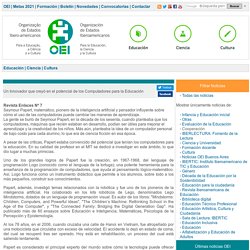
La gente se burló de Seymour Papert, en la década de los sesenta, cuando planteaba que los computadores, máquinas que recién estaban en desarrollo, podían ser útiles para mejorar el aprendizaje y la creatividad de los niños. Más aún, planteaba la idea de un computador personal de bajo costo para cada alumno, lo que era de ciencia ficción en esa época. A pesar de las críticas, Papert estaba convencido del potencial que tenían los computadores para la educación. Primera Tesis Doctoral en España sobre Pensamiento Computacional – Programamos.
Red de Recursos Educativos en Abierto. Pensamiento computacional Guía para profesores. Miradarelpe. DevTech Research Group at Tufts University. Computational thinking and thinking about computing. Beneficios del pensamiento computacional. El pensamiento computacional no es solamente aplicable al mundo informático, al contrario. Pensamientocomputacional. Computational Thinking for Educators - - Unit 1 - Introducing Computational Thinking. Computational Thinking (CT) is a problem solving process that includes a number of characteristics and dispositions. CT is essential to the development of computer applications, but it can also be used to support problem solving across all disciplines, including the humanities, math, and science. Students who learn CT across the curriculum can begin to see a relationship between academic subjects, as well as between life inside and outside of the classroom.
This course provides an opportunity to experience some of the elements of CT, including: Traduccion jeannette m wing computational thinking and thinking about computing. Computing Science in Primary Education Phil Bagge @baggiepr: Computational Thinking in the Primary Computing Curriculum. Over the summer I have been reflecting on what computational thinking is and how it affects primary computing understanding and practise. In this short article I am going to look at the following questions. · What is computational thinking? · Who first thought of the term? Computational Thinking for Educators - - Unit 1 - Introducing Computational Thinking. Mputer Science Terminology for Primary Teachers. Algorithms A precise step by step guide to achieving a specific outcome. We all use algorithms all the time but often don’t recognise them as such. The order we dress and wash could be described as a getting up algorithm. Posting a letter, dance steps, making a sandwich or preparing a cup of tea are other common algorithms.
In fact we all use algorithms every day of our lives. The important task for budding computer scientists is to break the steps of any algorithm up into the smallest possible steps that could be repeated by someone else or a computer. Algorithms & Programming All working programs are also algorithms. Logical Reasoning Logical reasoning is the systematic application of rules to problem solving and task completion. Teka - Programación en la Educación Escolar > Fundamentos > Artículos. Research Notebook: Computational Thinking.
BY Jason Togyer - Sun, 2011-03-06 16:03 By Jeannette M. Wing In a March 2006 article for the Communications of the ACM, I used the term "computational thinking" to articulate a vision that everyone, not just those who major in computer science, can benefit from thinking like a computer scientist [Wing06]. Pensamiento computacional, 10 años después – Programamos. En segundo lugar, Code.org es una organización sin ánimo de lucro, que se fundó en 2013, dedicada a la misión de ofrecer acceso a la educación de la informática para todo el mundo. Microsoft, junto a cientos de otras organizaciones, ayuda a financiar las actividades de code.org. Tercero, por todo el mundo hay una corriente que con interés en enseñar informática en primaria y secundaria. Computational thinking - Teaching Computing - National STEM Learning Centre. 0:05Skip to 0 minutes and 5 secondsIn this short screencast, we'll consider what we mean by computational thinking. 0:13Skip to 0 minutes and 13 secondsComputational thinking is at the core of the programme of study for computing.
It is the process of recognising aspects of computation in the world that surrounds us, and applying tools and techniques from the computing to understand and reason about the world around us. Basogain. ¿Qué es el pensamiento computacional? – Programamos. En el año 2006 Jeannette Wing publicó el artículo Computational thinking en el que defendía que esta nueva competencia debería ser incluida en la formación de todos los niños y niñas, ya que representa un ingrediente vital del aprendizaje de la ciencia, la tecnología, la ingeniería y las matemáticas. Traduccion jeannette m wing computational thinking and thinking about computing. ¿Por qué es importante promover que los estudiantes desarrollen su pensamiento computacional? Por Juan Carlos López García.
¿Qué es el pensamiento computacional? ¿Qué nos define como humanos? Pensamiento Computacional - Innovating Pedagogy.